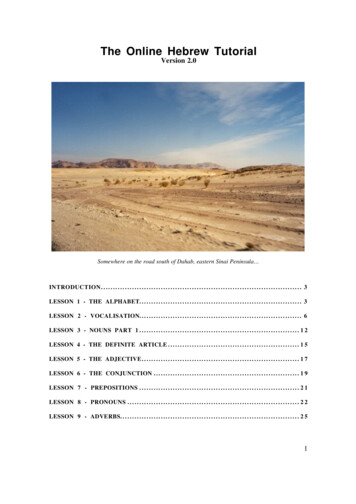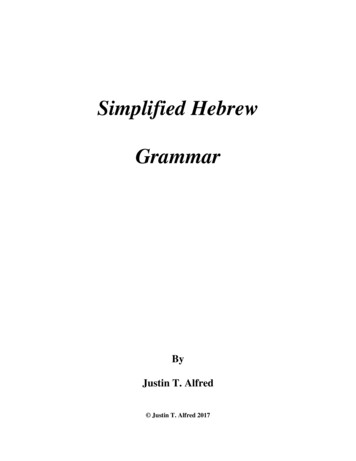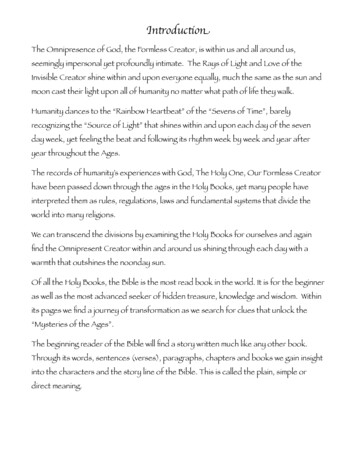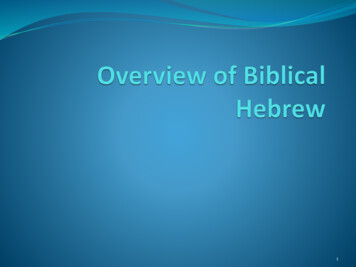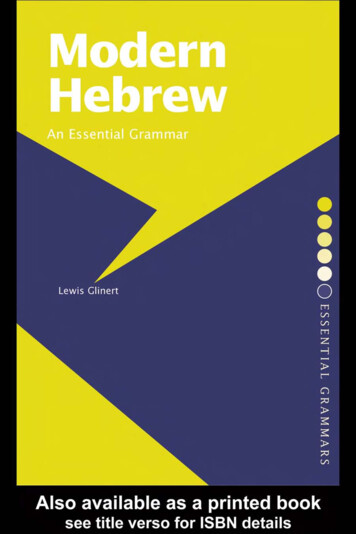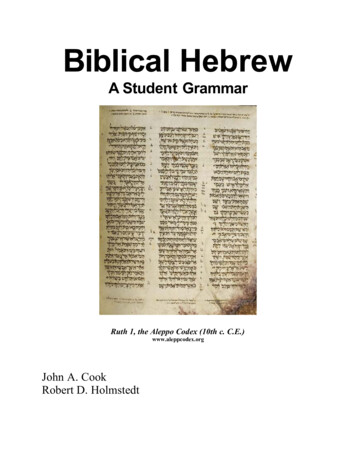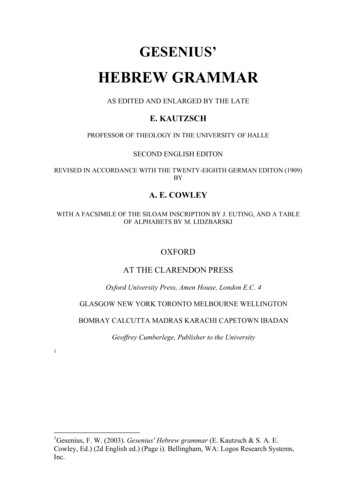
Transcription
GESENIUS’HEBREW GRAMMARAS EDITED AND ENLARGED BY THE LATEE. KAUTZSCHPROFESSOR OF THEOLOGY IN THE UNIVERSITY OF HALLESECOND ENGLISH EDITONREVISED IN ACCORDANCE WITH THE TWENTY-EIGHTH GERMAN EDITON (1909)BYA. E. COWLEYWITH A FACSIMILE OF THE SILOAM INSCRIPTION BY J. EUTING, AND A TABLEOF ALPHABETS BY M. LIDZBARSKIOXFORDAT THE CLARENDON PRESSOxford University Press, Amen House, London E.C. 4GLASGOW NEW YORK TORONTO MELBOURNE WELLINGTONBOMBAY CALCUTTA MADRAS KARACHI CAPETOWN IBADANGeoffrey Cumberlege, Publisher to the University11Gesenius, F. W. (2003). Gesenius' Hebrew grammar (E. Kautzsch & S. A. E.Cowley, Ed.) (2d English ed.) (Page i). Bellingham, WA: Logos Research Systems,Inc.
ECOND ENGLISH EDITION 1910REPRINTED LITHOGRAPHICALLY IN GREAT BRITAINAT THE UNIVERSITY PRESS, OXFORD, 1946, 1949, 1952, 1956FROM CORRECTED SHEETS OF THE SECOND EDITIONTRANSLATOR’S PREFACETHE translation of the twenty-sixth German edition of this grammar, originallyprepared by the Rev. G. W. Collins and revised by me, was published in 1898. Sincethat date a twenty-seventh German edition has appeared; and Prof. Kautzsch wasalready engaged on a twenty-eighth in 1908 when the English translation wasbecoming exhausted. He sent me the sheets as they were printed off, and I beganrevising the former translation in order to produce it as soon as possible after thecompletion of the German. The whole of the English has been carefully comparedwith the new edition, and, it is hoped, improved in many points, while Prof.Kautzsch’s own corrections and additions have of course been incorporated. Asbefore, the plan and arrangement of the original have been strictly followed, so thatthe references for sections and paragraphs correspond exactly in German and English.Dr. Driver has again most generously given up time, in the midst of otherengagements, to reading the sheets, and has made numerous suggestions. To him alsoare chiefly due the enlargement of the index of subjects, some expansions in the newindex of Hebrew words, and some additions to the index of passages, whereby wehope to have made the book more serviceable to students. I have also to thank myyoung friend, Mr. Godfrey R. Driver, of Winchester College, for some welcome helpin correcting proofs of the Hebrew index and the index of passages. בן חכם ישמח אב .Many corrections have been sent to me by scholars who have used the former Englishedition, especially the Rev. W. E. Blomfield, the Rev. S. Holmes, Mr. P. Wilson, Prof.Witton Davies, Mr. G. H. Skipwith, and an unknown correspondent at West Croydon.These, as well as suggestions in reviews, have all been considered, and wherepossible, utilized. I am also much indebted to the Press-readers for the great carewhich they have bestowed on the work.Finally, I must pay an affectionate tribute to the memory of Prof. Kautzsch, whodied in the spring of this year, shortly after finishing the last sheets of the twentyeighth edition. For more than thirty years he was indefatigable in improving thesuccessive editions of the Grammar. The German translation of the Old Testamentfirst published by him in 1894, with the co-operation of other scholars, under the titleDie Heilige Schrift des A Ts, and now (1910) in the third and much enlarged edition,is a valuable work which has been widely appreciated: the Apocryphen undPseudepigraphen des A Ts, edited by him in 1900, is another important work: besideswhich he published his Grammatik des Biblisch-Aramäischen in 1884, two usefulbrochures Bibelwissenschaft und Religionsunterricht in 1900, and Die bleibendeBedeutung des A Ts in 1903, six popular lectures on Die Poesie und die poetischenBücher des A Ts in 1902, his article ‘Religion of Israel’ in Hastings’ Dictionary of theBible, v. (1904), pp. 612–734, not to mention minor publications. His death is aserious loss to Biblical scholarship, while to me and to many others it is the loss of a
most kindly friend, remarkable alike for his simple piety and his enthusiasm forlearning.A. C.MAGDALEN COLLEGE, OXFORD,Sept. 1910.FROM THE GERMAN PREFACETHE present (twenty-eighth) edition of this Grammar,1 like the former ones, takesaccount as far as possible of all important new publications on the subject, especiallyJ. Barth’s Sprachwissenschaftliche Untersuchungen zum Semitischen, pt. i, Lpz. 1907;the important works of C. Brockelmann (for the titles see the heading of § 1; vol. i ofthe Grundriss was finished in 1908); P. Kahle’s Der masoretische Text des A Ts nachder Überlieferung der babylonischen Juden, Lpz. 1902 (giving on p. 51 ff. an outlineof Hebrew accidence from a Babylonian MS. at Berlin); R. Kittel’s Biblia Hebraica,Lpz. 1905 f., 2 vols. (discriminating between certain, probable, and proposedemendations; see § 3 g, end); Th. Nöldeke’s Beiträge zur semit. Sprachwissenschaft,Strassburg, 1904; Ed. Sievers’ Metrische Studien (for the titles of these striking workssee § 2 r). The important work of J. W. Rothstein, Grundzüge des hebr. Rhythmus,&c. (see also § 2 r), unfortunately appeared too late to be used. The two largecommentaries edited by Nowack and Marti have been recently completed; and in P.Haupt’s Polychrome Bible (SBOT.), part ix (Kings) by Stade and Schwally waspublished in 1904.For full reviews of the twenty-seventh edition, which of course have beenconsidered as carefully as possible, I have to thank Max Margolis (in Hebraica, 1902,p. 159 ff.), Mayer Lambert (REJ. 1902, p. 307 ff.), and H. Oort (Theol. Tijdschrift,1902, p. 373 ff.). For particular remarks and corrections I must thank Prof. J. Barth(Berlin), Dr. Gasser, pastor in Buchberg, Schaffhausen, B. Kirschner, ofCharlottenburg, (contributions to the index of passages), Pastor Köhler, of Augst, Dr.Liebmann, of Kuczkow, Posen, Prof. Th. Nöldeke, of Strassburg, Pastor S. Preiswerkjunior, of Bâle, Dr. Schwarz, of Leipzig, and Prof. B. Stade, of Giessen (died in1906). Special mention must be made of the abundant help received from three oldfriends of this book, Prof. P. Haupt, of Baltimore, Prof. Knudtzon, of Kristiania, andProf. H. Strack, of Berlin, and also, in connexion with the present edition, Prof. H.1 1 The first edition appeared at Halle in 1813 (202 pp. small 8vo); twelve moreeditions were published by W. Gesenius himself, the fourteenth to the twenty first(1845–1872) by E. Rödiger, the twenty-second to the twenty-eighth (1878–1910) byE. Kautzsch. The first abridged edition appeared in 1896, the second at the same timeas the present (twenty-eighth) large edition. The first edition of the ‘Übungsbuch’(Exercises) to Gesenius-Kautzsch’s Hebrew Grammar appeared in 1881, the sixth in1908.SBOT. SBOT. Sacred Books of the Old Testament, ed. by P. Haupt. Lpz. andBaltimore, 1893 ff.REJ. REJ. Revue des Études Juives. Paris, 1880 ff.
Hyvernat, of the University of Washington, who has rendered great service especiallyin the correction and enlargement of the indexes. I take this opportunity of thankingthem all again sincerely. And I am no less grateful also to my dear colleague Prof. C.Steuernagel for the unwearying care with which he has helped me from beginning toend in correcting the proof-sheets.Among material changes introduced into this edition may be mentioned theabolition of the term Šewâ medium (§ 10 d). In this I have adopted, not withouthesitation, the views of Sievers. I find it, however, quite impossible to follow him inrejecting all distinctions of quantity in the vowels. It is no doubt possible that suchmatters may in the spoken language have worn a very different appearance, andespecially that in the period of nearly a thousand years, over which the Old Testamentwritings extend, very great variations may have taken place. Our duty, however, is torepresent the language in the form in which it has been handed down to us by theMasoretes; and that this form involves a distinction between unchangeable, tone-long,and short vowels, admits in my opinion of no doubt. The discussion of any earlierstage of development belongs not to Hebrew grammar but to comparative Semiticphilology.The same answer may be made to Beer’s desire (ThLZ. 1904, col. 314 f.) for an‘historical Hebrew grammar describing the actual growth of the language on a basisof comparative philology, as it may still be traced within the narrow limits of the OldTestament’. Such material as is available for the purpose ought indeed to be honestlyset forth in the new editions of Gesenius; but Beer seems to me to appraise suchmaterial much too highly when he refers to it as necessitating an ‘historical grammar’.In my opinion these historical differences have for the most part been obliterated bythe harmonizing activity of the Masoretes.E. KAUTZSCH.HALLE,July, 1909.ADDITIONS AND CORRECTIONSPage 42, line 13 from below, for note 1 read note 3.Page 63, § 15 p. [See also Wickes, Prose Accentuation, 130 f., 87 n. (who,however, regards the superlinear, Babylonian system as the earlier); and Ginsburg,Introduction to the Hebrew Bible, 76, 78. In Ginsburg’s Hebrew Bible, ed. 2 (1908),pp. 108 f., 267 f., the two systems of division are printed in extenso, in parallelcolumns—the 10 verses of the superlinear (Babylonian) system consisting (inExodus) of v.2.3–6.7.8–11.12.13.14.15.16.17 (as numbered in ordinary texts), and the 12 versesThLZ. ThLZ. Theologische Literaturzeitung, ed. by E. Schürer. Lpz. 1876 ff.
of the sublinear (Palestinian) system, consisting of v.2–3.4.5.6.7.8.9.10.11.12.13–16.17.—S. R.D.]Page 65, note 1, for ֽאָ֫נָּא read ( אָ֫נָּ֫א as § 105 a).[Editions often vary in individual passages, as regards the accentuation of the firstsyllable: but in the 7 occurrences of אנא , and the 6 of אנה , Baer, Ginsburg, and Kittelagree in having an accent on both syllables (as )אָ֣נָּ֗א in Gn 50:17, Ex 32:31, Ps116:16, and Metheg on the first syllable and an accent on the second syllable (as ) ֽאָנָּ֣ה in 2 K 20:3 Is 38:3, Jon 1:14, 4:2, Ps 116:4, 118:25, 25, Dn 9:4, Ne 1:5, 11, exceptthat in Ps 116:4 Ginsburg has אָנָּ֥ה .—S. R. D.]Page 79, § 22 s, before ִה ְרּדִיפֻהוּ insert exceptions to b are. After Jer 39:12 add Ps52:5; and for Ez 9:6 read Ezr 9:6.[So Baer (cf. his note on Jud 20:43; also on Jer 39:12, and several of the otherpassages in question): but Ginsburg only in 10 of the exceptions to b, and Jacob benḤayyim and Kittel only in 5, viz. Jer 39:12, Pr 11:21, 15:1, Ps 52:5, Ezr 9:6.—S. R.D.]Page 111, line 12, for הַהוּה read הַהוּא .Page 123, § 45 e, add: cf. also ַמ ְה ֵפּכָה followed by את , Is 13:19, Am 4:11 (§ 115 d).Page 175, § 67; . See B. Halper, ‘The Participial formations of the GeminateVerbs’ in ZAW. 1910, pp. 42 ff., 99 ff., 201 ff. (also dealing with the regular verb).Page 177, at the end of § 67 g the following paragraph has been accidentallyomitted:Rem. According to the prevailing view, this strengthening of the first radical ismerely intended to give the bi-literal stem at least a tri-literal appearance. (Possiblyaided by the analogy of verbs פ״ן , as P. Haupt has suggested to me in conversation.)But cf. Kautzsch, ‘Die sog. aramaisierenden Formen der Verba ע״ע im Hebr.’ inOriental. Studien zum 70. Geburtstag Th. Nöldekes, 1906, p. 771 ff. It is there shown(1) that the sharpening of the 1st radical often serves to emphasize a particularmeaning (cf. יִגָּר , but יְגֹ ֵר֫הוּ , יָחֵל and יַחֵל , יִסֹּב , and יָסֹב , יִשֹּׁם and ֵשׁם ַ )הּ , and elsewhereno doubt to dissimilate the vowels (as יִגָּר , יִדַּל never יָגַר , & יָדַל c.): (2) that thesharpening of the 1st radical often appears to be occasioned by the nature of the firstletter of the stem, especially when it is a sibilant. Whether the masoreticpronunciation is based on an early tradition, or the Masora has arbitrarily adoptedaramaizing forms to attain the above objects, must be left undecided.Page 193, the second and third paragraphs should have the marginal letters d and erespectively.ZAW. ZAW, Zeitschrift für die alttestamentliche Wissenschaft, ed. by B. Stade,Giessen, 1881 ff., and since 1907 by K. Marti.
Page 200, § 72 z, line 2, after Est 2:18 add 4:14.Page 232, § 84a s, add שֹׁ ֵממָה 2 S 13:20.Page 236, § 85 c, add ַהנְזָקָה Ezr 4:22.Page 273, § 93 qq end, add מוֹסֵרוֹת Jer 5:5, ִר ֵבּעִים , ֵשׁ֥ים ִ ִשׁלּ Ex 20:5, שֹׁמֵמוֹת Is 49:8, שֹׁ ֵממִים La 1:16 (cf. König, ii. 109).LIST OF ABBREVIATIONSThe following abbreviations have occasionally been used for works andperiodicals frequently quoted:—AJSL.CIS. American Journal of Semitic Languages. Corpus Inscriptionum Semiticarum.Ed.Mant. Biblia Hebraica ex recensione Sal. Norzi edidit Raphael Ḥayyim Basila,Mantuae 1742–4.Jabl. Biblia Hebraica ex recensione D. E. Jablonski, Berolini, 1699.JQR. Jewish Quarterly Review.KAT.3 Die Keilinschriften und das Alte Testament, 3rd ed. by H. Zimmern and H.Winckler, 2 vols., Berlin, 1902 f.LexiconNB. A Hebrew and English Lexicon of the Old Testament, based on theThesaurus and Lexicon of Gesenius, by F. Brown, S. R. Driver,and C. A. Britts, Oxford, 1906. J. Barth, Die Nominalbildung in den semitischen Sprachen. Lpz. 1889–94.NGGW. Nachrichten der Göttinger Gesellschaft der Wissenschaften.OLZ. Orientalistische Literaturzeitung. Vienna, 1898 ff.PRE. Realencyclopädie für protestantische Theologie und Kirche, 3rd ed. by A.Hauck. Lpz. 1896 ff.PSBA Proceedings of the Society of Biblical Archæology. London, 1879 ff.REJ. Revue des Études Juives. Paris, 1880 ff.Sam. The (Hebrew) Pentateuch of the Samaritans.
SBOT. Sacred Books of the Old Testament, ed. by P. Haupt. Lpz. and Baltimore,1893 ff.ThLZ. Theologische Literaturzeitung, ed. by E. Schürer. Lpz. 1876 ff.VB. Vorderasiatische Bibliothek, ed. by A. Jeremias and H. Winckler. Lpz. 1907ff.ZA. Zeitschrift für Assyriologie und verwandte Gebiete, ed. by C. Bezold. Lpz.1886 ff.ZAW.ZDMG.ZDPV. Zeitschrift für die alttestamentliche Wissenschaft, ed. by B. Stade, Giessen,1881 ff., and since 1907 by K. Marti. Zeitschrift der deutschen morgenländischen Gesellschaft, Lpz. 1846 ff.,since 1903 ed. by A. Fischer. Zeitschrift des deutschen Palästinavereins, Lpz. 1878 ff., since 1903 ed.by C. Steuernagel.
HEBREW GRAMMARINTRODUCTION§ 1. The Semitic Languages in General.B. Stade, Lehrb. der hebr. Gramm., Lpz. 1879, § 2 ff.; E. König, Hist.-krit. Lehrgeb. derhebr. Spr., i. Lpz. 1881, § 3; H. Strack, Einl. in das A.T., 6th ed., Munich, 1906, p. 231 ff.(a good bibliography of all the Semitic dialects); Th. Nöldeke, article ‘SemiticLanguages’, in the 9th ed. of the Encycl. Brit. (Dis semit. Sprachen, 2nd ed., Lpz. 1899),and Beitr. zur sem. Sprachwiss., Strassb., 1904; W. Wright, Lectures on the ComparativeGrammar of the Semitic Languages, Cambr. 1890; H. Reckendorf, ‘Zur Karakteristik dersem. Sprachen, ’ in the Actes du Xme Congrès internat. des Orientalistes (at Geneva in1894), iii. 1 ff., Leiden, 1896; O. E. Lindberg, Vergl. Gramm. der sem. Sprachen, i A:Konsonantismus, Gothenburg, 1897; H. Zimmern, Vergl. Gramm. der sem. Sprachen,Berlin, 1898; E. König, Hebräisch und Semitisch: Prolegomena und Grundlinien einerGesch. der sem. Sprachen, &c., Berlin, 1901; C. Brockelmann, SemitischeSprachwissenschaft, Lpz. 1906, Grundriss der vergl. Gramm. der sem. Sprachen, vol. i(Laut- und Formenlehre), parts 1–5, Berlin, 1907 f. and his Kurzgef. vergleichendeGramm. (Porta Ling. Or.) Berlin, 1908.—The material contained in inscriptions has beenin process of collection since 1881 in the Paris Corpus Inscriptionum Semiticarum. Tothis the best introductions are M. Lidzbarski’s Handbuch der Nordsem. Epigraphik,Weimar, 1898, in 2 parts (text and plates), and his Ephemeris zur sem. Epigraphik (5parts published), Giessen, 1900 f. [G. A. Cooke, Handbook of North-Semitic Inscriptions,Oxford, 1903].1. The Hebrew language is one branch of a great family of languages in WesternAsia which was indigenous in Palestine, Phoenicia, Syria, Mesopotamia, Babylonia,Assyria, and Arabia, that is to say, in the countries extending from the Mediterraneanto the other side of the Euphrates and Tigris, and from the mountains of Armenia tothe southern coast of Arabia. In early times, however, it spread from Arabia overAbyssinia, and by means of Phoenician colonies over many islands and sea-boards ofthe Mediterranean, as for instance to the Carthaginian coast. No comprehensivedesignation is found in early times for the languages and nations of this family; thename Semites or Semitic1 languages (based upon the fact that according to Gn 10:21ff. almost all nations speaking these languages are descended from Shem) is,however, now generally accepted, and has accordingly been retained here.21 1 First used by Sohlözer in Eichhorn’s Repertorium für bibl. u. morgenl. Literatur,1781, p. 161.2 2 From Shem are derived (Gn 10:21 ff.) the Aramaean and Arab families as well asthe Hebrews, but not the Canaanites (Phoenicians), who are traced back to Ham (vv.6.15 ff.), although their language belongs decidedly to what is now called Semitic. Thelanguage of the Babylonians and Assyrians also was long ago shown to be Semitic,just as Aššur (Gn 10:22) is included among the sons of Shem.
2. The better known Semitic languages may be subdivided1 as follows:—I. The South Semitic or Arabic branch. To this belong, besides the classicalliterary language of the Arabs and the modern vulgar Arabic, the older southernArabic preserved in the Sabaean inscriptions (less correctly called Himyaritic), and itsoffshoot, the Ge ez or Ethiopic, in Abyssinia.II. The Middle Semitic or Canaanitish branch. To this belongs the Hebrew of theOld Testament with its descendants, the New Hebrew, as found especially in theMishna (see below, § 3 a), and Rabbinic; also Phoenician, with Punic (in Carthageand its colonies), and the various remains of Canaanitish dialects preserved in namesof places and persons, and in the inscription of Mêša , king of Moab.III. The North Semitic or Aramaic branch. The subdivisions of this are—(1) TheEastern Aramaic or Syriac, the literary language of the Christian Syrians. Thereligious books of the Mandaeans (Nasoraeans, Sabians, also called the disciples ofSt. John) represent a very debased offshoot of this. A Jewish modification of Syriac isto be seen in the language of the Babylonian Talmud. (2) The Western or PalestinianAramaic, incorrectly called also ‘Chaldee’.2 This latter dialect is represented in theOld Testament by two words in Gn 31:47, by the verse Jer 10:11, and the sections Dn2:4 to 7:28; Ezr 4:8 to 6:18, and 7:12–26, as well as by a number of non-Jewishinscriptions and Jewish papyri (see below, under m), but especially by a considerablesection of Jewish literature (Targums, Palestinian Gemara, &c.). To the same branchbelongs also the Samaritan, with its admixture of Hebrew forms, and, except for therather Arabic colouring of the proper names, the idiom of the Nabataean inscriptionsin the Sinaitic peninsula, in the East of Palestine, &c.For further particulars about the remains of Western Aramaic (including those in the NewTest., in the Palmyrene and Egyptian Aramaic inscriptions) see Kautzsch, Gramm. desBiblisch-Aramäischen, Lpz. 1884, p. 6 ff.IV. The East Semitic branch, the language of the Assyrio-Babylonian cuneiforminscriptions, the third line of the Achaemenian inscriptions.On the importance of Assyrian for Hebrew philology especially from a lexicographicalpoint of view cf. Friedr. Delitzsch, Prolegomena eines neuen hebr.-aram. Wörterbuchs zumA. T., Lpz. 1886; P. Haupt, ‘Assyrian Phonology, &c.,’ in Hebraica, Chicago, Jan. 1885, vol.i. 3; Delitzsch, Assyrische Grammatik, 2nd ed., Berlin, 1906.If the above division into four branches be reduced to two principal groups, No. I,as South Semitic, will be contrasted with the three North Semitic branches.11 1 For conjectures as to the gradual divergence of the dialects (first the Babylonian,then Canaanite, including Hebrew, lastly Aramaic and Arabic) from primitiveSemitic, see Zimmern, KAT.3, ii. p. 644 ff.2 2 In a wider sense all Jewish Aramaic is sometimes called ‘Chaldee’.1 1 Hommel, Grundriss der Geogr. und Gesch. des alten Orients, Munich, 1904, p. 75ff., prefers to distinguish them as Eastern and Western Semitic branches. Theirgeographical position, however, is of less importance than the genealogical relation of
All these languages stand to one another in much the same relation as those of theGermanic family (Gothic, Old Norse, Danish, Swedish; High and Low German in their earlierand later dialects), or as the Slavonic languages (Lithuanian, Lettish; Old Slavonic, Serbian,Russian; Polish, Bohemian). They are now either wholly extinct, as the Phoenician andAssyrian, or preserved only in a debased form, as Neo-Syriac among Syrian Christians andJews in Mesopotamia and Kurdistan, Ethiopic (Ge ez) in the later Abyssinian dialects(Tigrê, Tigriña, Amharic), and Hebrew among some modern Jews, except in so far as theyattempt a purely literary reproduction of the language of the Old Testament. Arabic alone hasnot only occupied to this day its original abode in Arabia proper, but has also forced its wayin all directions into the domain of other languages.The Semitic family of languages is bounded on the East and North by another of stillwider extent, which reaches from India to the western limits of Europe, and is called IndoGermanic2 since it comprises, in the most varied ramifications, the Indian (Sanskrit), Old andNew Persian, Greek, Latin, Slavonic, as well as Gothic and the other Germanic languages.With the Old Egyptian language, of which Coptic is a descendant, as well as with thelanguages of north-western Africa, the Semitic had from the earliest times much in common,especially in grammatical structure; but on the other hand there are fundamental differencesbetween them, especially from a lexicographical point of view; see Erman, ‘Das Verhältnisdes Aegyptischen zu den semitischen Sprachen, ’ in the ZDMG. xlvi, 1892, p. 93 ff., andBrockelmann, Grundriss, i. 3.3. The grammatical structure of the Semitic family of languages, as comparedwith that of other languages, especially the Indo-Germanic, exhibits numerouspeculiarities which collectively constitute its distinctive character, although many ofthem are found singly in other languages. These are—(a) among the consonants,which in fact form the substance of these languages, occur peculiar gutturals ofdifferent grades; the vowels are subject, within the same consonantal framework, togreat changes in order to express various modifications of the same stem-meaning; (b)the word-stems are almost invariably triliteral, i.e. composed of three consonants; (c)the verb is restricted to two tense-forms, with a peculiarly regulated use; (d) the nounhas only two genders (masc. and fem.); and peculiar expedients are adopted for thepurpose of indicating the case-relations; (e) the oblique cases of the personal pronoun,as well as all the possessive pronouns and the pronominal object of the verb, aredenoted by forms appended directly to the governing word (suffixes); (f) the almostcomplete absence of compounds both in the noun (with the exception of many propernames) and in the verb; (g) great simplicity in the expression of syntactical relations,e.g. the small number of particles, and the prevalence of simple co-ordination ofclauses without periodic structure. Classical Arabic and Syriac, however, form a notunimportant exception as regards the last-mentioned point.4. From a lexicographical point of view also the vocabulary of the Semites differsessentially from that of the Indo-Germanic languages, although there is apparentlymore agreement here than in the grammar. A considerable number of Semitic rootsand stems agree in sound with synonyms in the Indo-Germanic family. But apart fromthe various groups of dialects, as rightly pointed out by A. Jeremias in Th.LZ. 1906,col. 291.2 2 First by Klaproth in Asia Polyglotta, Paris, 1823; cf. Leo Meyer in Nachrichten d.Gött. Gesellschaft, 1901, p. 454.ZDMG. ZDMG. Zeitschrift der deutschen morgenländischen Gesellschaft, Lpz.1846 ff., since 1903 ed. by A. Fischer.
expressions actually borrowed (see below, under i), the real similarity may be reducedto imitative words (onomatopoetica), and to those in which one and the same idea isrepresented by similar sounds in consequence of a formative instinct common to themost varied families of language. Neither of these proves any historic or genericrelation, for which an agreement in grammatical structure would also be necessary.Comp. Friedr. Delitzsch, Studien über indogermanisch-semitische Wurzelverwandtschaft,Lpz. 1873; Nöldechen, Semit. Glossen zu Fick und Curtius, Magdeb. 1876 f.; McCurdy,Aryo-Semitic Speech, Andover, U.S.A., 1881. The phonetic relations have been thoroughlyinvestigated by H. Möller in Semitisch und Indogermanisch, Teil i, Konsonanten,Copenhagen and Lpz. 1907, a work which has evoked considerable criticism.As onomatopoetic words, or as stem-sounds of a similar character, we may compare, e.g. ָלקַק , ָל ַח ְך λέχω, lingo, Skt. lih, Eng. to lick, Fr. lécher, Germ. lecken; ( גָּלַל cf. אָגַל , ) ָעגַל κυλίω,volvo, Germ. quellen, wallen, Eng. to well; גָּרַד , ָחרַט , ָחרַת , χαράττω, Pers. khârı̂dan, Ital.grattare, Fr. gratter, Eng. to grate, to scratch, Germ. kratzen; ָפּרַק frango, Germ. brechen,&c.; Reuss, Gesch. der hl. Schriften A.T.’s, Braunschw. 1881, p. 38, draws attention moreoverto the Semitic equivalents for earth, six, seven, horn, to sound, to measure, to mix, to smell, toplace, clear, to kneel, raven, goat, ox, &c. An example of a somewhat different kind is am,ham (sam), gam, kam, in the sense of the German samt, zusammen, together; in Hebrew אָמַם (whence ֻאמָּה people, properly assembly), ( עִם with) samt, גַּם also, moreover, Arab. גּמע tocollect; Pers. ham, hamah (at the same time); Skt. samâ (with), Gk. ἅµα (ἄµφω), ὁµός, ὁµοῦ(ὅµιλος, ὅµαδος, and harder κοινός, Lat. cum, cumulus, cunctus; with the correspondingsibilant Skt. sam, Gk. σύν, ξύν, ξυνόσ κοινός, Goth. sama, Germ. samt, sammeln; but manyof these instances are doubtful.Essentially different from this internal connexion is the occurrence of the samewords in different languages, where one language has borrowed directly from theother. Such loan-words are—(a) In Hebrew: some names of objects which were originally indigenous in Babylonia andAssyria (see a comprehensive list of Assyrio-Babylonian loan-words in the Hebrew andAramaic of the Old Testament in Zimmern and Winckler, KAT.3, ii. p. 648 ff.), in Egypt,Persia, or India, e.g. ( יְאֹר also in the plural) river, from Egyptian yoor, generally as the nameof the Nile (late Egypt. yaro, Assyr. yaruu), although it is possible that a pure Semitic יאר hasbeen confounded with the Egyptian name of the Nile (so Zimmern); ( אָ֫חוּ Egyptian) Nile-reed(see Lieblein, ‘Mots égyptiens dans la Bible, ’ in PSBA. 1898, p. 202 f.); ( ַפּ ְרדֵּס in Zendpairidaêza, circumvallation παράδεισος) pleasure-garden, park; ֲא ַדרְכּוֹן daric, Persian goldcoin; ֻתּ ִכּיִּים peacocks, perhaps from the Malabar tôgai or tôghai. Some of these words are alsofound in Greek, as ( ַכּ ְרפַּס Pers. karbâs, Skt. karpâsa) cotton, κάρπασος, carbasus. On the otherhand it is doubtful if קוֹף corresponds to the Greek κῆπος, κῆβος, Skt. kapi, ape.(b) In Greek, &c.: some originally Semitic names of Asiatic products and articles ofcommerce, e.g. בּוּץ βύσσος, byssus; לְבֹנָה λίβανος, λιβανωτός, incense; ָקנֶה κάνη κάννα,canna, cane; כַּמֹּן κύµινον, cuminum, cumin; ְקצִיעָה κασσία, cassia; גָּמָל κάµηλος, camelus; ֵערָּֽבוֹן ἀρραβών, arrhabo, arrha, pledge. Such transitions have perhaps been brought aboutchiefly by Phoenician trade. Cf. A. Müller, ‘Semitische Lehnworte im aälteren Griechisch, ’in Bezzenberger’s Beiträge zur Kunde der Indo-germ. Sprachen, Göttingen, 1877, vol. i. p.273 ff.; E. Ries. Quae res et vocabula a gentibus semiticis is in Graeciam pervencerint,KAT. KAT.3 Die Keilinschriften und das Alte Testament, 3rd ed. by H. Zimmernand H. Winckler, 2 vols., Berlin, 1902 f.PSBA. PSBA Proceedings of the Society of Biblical Archæology. London, 1879 ff.
Breslau, 1890; Muss-Aruolt, ‘Semitic words in Greek and Latin,’ in the Transactions of theAmerican Philological Association, xxiii. p. 35 ff.; H. Lewy, Die semitischen Fremdwörter imGriech., Berlin, 1895; J. H. Bondi, Dem hebr.-phöniz. Sprachzweige angehör. Lehnwörter inhieroglyph. u. hieratischen Texten, Lpz. 1886.5. No system of writing is ever so perfect as to be able (o reproduce the sounds ofs language in all their various shades, and the writing of the Semites has one strikingfundamental defect, viz. that only the consonants (which indeed form the substance ofthe language) are written as real letters,1 whilst of the vowels only the longer areindicated by certain representative consonants (see below, § 7). It was only later thatspecial small marks (points or strokes below or above the consonants) were inventedto represent to the eye all the vowel-sounds (see § 8). These are, however, superfluousfor the practised reader, and are therefore often wholly omitted in Semitic manuscriptsand printed texts. Semitic writing, moreover, almost invariably proceeds from right toleft.2With the exception of the Assyrio-Babylonian (cuneiform), all varieties of Semiticwriting, although differing widely in some respects, are derived from one and thesame original alphabet, represented on extant monuments most faithfully by thecharacters used on the stele of Mêša , king of Moab (see below, § 2 d), and in the oldPhoenician inscriptions, of which the bronze howls from a temple of Baal (CIS. i. 22ff. and Plate IV) are somewhat earlier than Mêša . The old Hebrew writing, as itappears on the oldest monument, the Siloam inscription (see below, § 2 d), exhibitsessentially the same character. The old Greek, and indirectly all European alphabets,are descended from the old Phoenician writing (see § 5 i).See the Table of Alphabets at the beginning of the Grammar, which shows the relations ofthe older varieties of
hebrew grammar as edited and enlarged by the late e. kautzsch professor of theology in the university of halle second english editon revised in accordance with the twenty-eighth german editon (1909) by a. e. cowley with a facsimile of the siloam inscription by j. euting, and a table of


